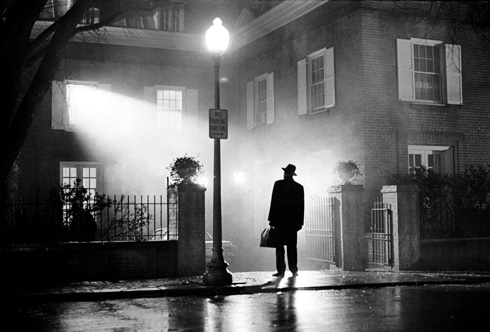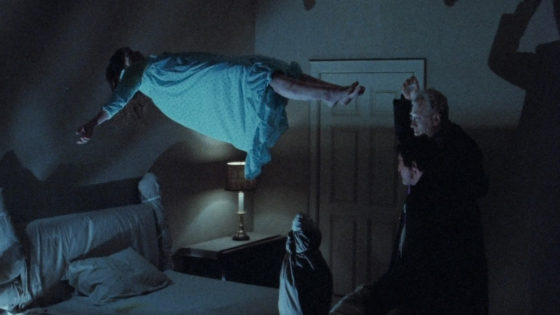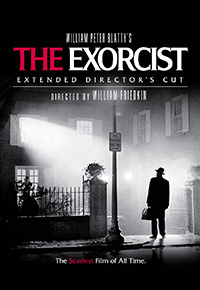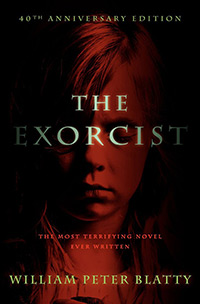Social media has helped to propagate the belief in blasphemy, levitation, and speaking in tongues as hallmarks of demonic possession. Since the death of William Peter Blatty—the author best known for his novel turned blockbuster film The Exorcist— exorcism is, once again, showing a robust presence in contemporary life, this time among millennials. In this article, Kathy Schultheis warns that this resurgence of interest in exorcism is a sign of how far reason has fallen.
William Peter Blatty, the author best known for his novel turned blockbuster film The Exorcist, died January 12, 2017 at the age of 89. While the Catholic Legion of Decency in 1971 consigned Blatty’s novel to the “condemned” list, the contemporary Catholic press has been most generous in its praise of Blatty, elegizing him as a prophet who warned a generation hell-bent on materialism of the wages of sin and the temptations of the devil. According to this line of thinking, Blatty was a new Paul who fought the good fight to get his film made against a stubborn Church that didn’t want its most cryptic doctrine advertised to a disbelieving world. Of course, The Exorcist turned out to have the opposite effect: It was a monster hit and far more successful than any fire and brimstone sermon in scaring prideful mortals into giving up their sinful ways.

The iconic scene from The Exorcist: Merrin arrives
In truth, what Blatty did by writing this horror classic was make truckloads of money and in the process engender many real-life simulacra in which people, either mentally ill or hungering for their fifteen minutes, began to rant, moan and summon Roman-collared clerics to don their white stoles and brandish their crucifixes to drive out the offending spirits. Blatty’s novel made respectable again a grotesque practice that had been used for centuries with malicious intent upon the mentally ill. Under the legitimizing force of The Exorcist, the embarrassing stigma that had always surrounded exorcism was transfigured, and normally skeptical people began to believe in the Old One again.
Social media has helped to propagate the belief in blasphemy, levitation, and speaking in tongues as hallmarks of demonic possession.
With Blatty’s death, the subject of exorcism has re-entered national discourse. Was Blatty right? Are there dark energies that can pull the evilly inclined down to everlasting fire? To entertain such a droll question is a sign of how far reason has fallen. But reason doesn’t matter; this urban legend is speaking powerfully once again, this time to millennials, as it did to their parents and grandparents who cued up for hours in 1974 to see the film. Given the state of our polarized and superstitious national social climate, exorcists, like psychics, are in high demand. Social media has helped to propagate the belief in blasphemy, levitation, and speaking in tongues as hallmarks of demonic possession. In 2014, Pope Francis called to the Vatican a convocation of exorcists and praised them for their work in the field. Both of Francis’s predecessors, Pope John-Paul II, who exorcised many troubled people, and Benedict who approved many exorcisms, firmly endorsed a practice, which panders to the worst in the human species: the tendency to locate evil in a metaphysical entity, rather than in misfiring neural transmitter or the propensity to take secret delight in projecting upon the alien other the disavowed impulses that lurk within one’s own self. As Meghan Hamilton observed, “Belief in exorcism requires a particular kind of irrationality.”
![William Peter Blatty inside of his home office in 2009. Photo by jtblatty (Own work) [CC BY 4.0 (http://creativecommons.org/licenses/by/4.0)], via Wikimedia Commons (https://commons.wikimedia.org/wiki/File:William-Peter-Blatty-2009.jpg)](https://www.skeptic.com/eskeptic/2017/images/17-05-31/William-Peter-Blatty-2009.jpg)
William Peter Blatty inside of his home office in 2009. Photograph by jtblatty (own work) [CC BY 4.0], via Wikimedia Commons.
So what is the nature of this irrationality? It is one that violates the law of contradiction. To believe in exorcism is to believe that the human self is capable of being invaded by an evil spirit who, once upon a time, was god’s rebel angel. Lucifer fell, so the Bible narrates, for the same reason that Adam fell: he was proud. Lucifer wanted to rule in hell rather than serve in heaven. By all biblical accounts, he elected to disobey god, then out of frustration with his new condition, he spent the rest of eternity as Satan, making mischief and suborning terrestrials, the soon-to-be-dead, to select the same bad option. Lucifer chose, so this line of reasoning goes, and thus he has only himself to blame, as do all proud, self-worshipping mortals, who do not acknowledge their flawed, god-dependent natures.
But herein lies the contradiction: How can it be logically maintained that Lucifer chose? For who would be so base as to create a being only to watch him roast forever on hell’s rotisserie? If god gave Lucifer free choice and god is all-knowing and all-powerful, would he not then see into the future and know what “choice” Lucifer, like Adam after him, would make? Why tempt Lucifer then? What manner of god would do this? Only, it would seem, a sadistic god, one who enjoys watching his foolish created beings fritter away their misspent lives? Another question follows: Why force an eternity of suffering upon a creature, who through no fault of his own, “chose” badly? To consign such a being to eternal flames would seem morally indefensible. How, except through sophistry and casuistry, can such a belief be maintained?
And those tactics—sophistry and casuistry—are precisely the stratagems deployed by the Catholic Church in the 16th century when exorcisimus was born. In response to the Reformation sweeping across Europe, the Church, fearing the loss of Europe to Luther, doubled down and launched the Counter-Reformation, the Inquisition, the Jesuits, and exorcism. While Galileo was consigned to a dungeon in Italy for initially refusing to recant his findings, a Catholic priest, one Girolamo Menghi, labored away on a massive book on demonology, a work that was soon to become a handbook for exorcists. Father Menghi’s tome listed in mind-numbing detail the signs of possession—speaking in tongues, vomiting, perverse actions—all hallmarks of the Blatty’s possessed child Regan in The Exorcist. The Vatican approved and codified Menghi’s findings and set about exorcising tens of thousands of people whom the Church judged to be possessed. Anyone exhibiting so much as a hint of mental illness could be subjected to this hideous practice that invariably made the sick person much sicker, launching him or her often on the path of suicide.
It is the way The Exorcist elides psychological explanation that makes it—for those who can see it—so emotionally satisfying. People are ambivalent about the disgusting. That which inspires revulsion also inspires a kind of delight. If people can locate such disgust, as an earlier generation of movie-goers did, in a “bad seed,” a genetic propensity to evil and thus something extrinsic to the self, they can enjoy a second-hand experience of disgust with no threat to their own psyches. When Patty McCormick, the child actress who played Rhoda, the murderous child in The Bad Seed, was struck by lightning at the end of the film, a generation of parents in the 1950s clapped in movie houses across the country, gleeful that the Freudians who would locate Rhoda’s malevolent acts in a troubled early life, had been silenced by an evil that was motiveless, capricious, and resistant to all explanation. When Linda Blair’s head spins in The Exorcist and she spews green vomit, Father Karras, her priest, invites the evil one to “Take me.” The devil obliges, and the priest falls to his death possessed, but presumably through his act of martyrdom, killing the evil that had once possessed the child.
Blatty’s novel made respectable again a grotesque practice that had been used for centuries with malicious intent upon the mentally ill.
Yet, what the film struggled to deny—causal explanation—is what it inadvertently reveals. The real possession going on in the plotline of The Exorcist is not Regan’s by the devil; it is Father Karras’s possession at the hands of his mother. At the beginning of the film, Karras is shown struggling to find his mother in a Dantean Inferno for the mentally ill. He is losing his faith and feels that he should leave the priesthood to care for his ill mother. Then his mother’s brother joins him at the hospital, saying to him, “You know it’s funny, if you wasn’t a priest, you’d be a famous psychiatrist on Park Avenue. Your mother would be in a penthouse instead of here.” When Karras finally finds his mother in this nether world of the insane, she is tied to her bed by restraints. In her bitter anguish, she glares at her son and asks accusingly, “Dimi, why you do this to me?”
The son’s guilt for having divested himself of his mother is reborn in the altercation with the possessed child and the devil. Exorcism is Karros’s attempt to deliver the girl symbolically from the same invasive spirit that has possessed him all his life. When Father Karras falls to his death in the act of exorcising Regan, he is, in turn, possessed. He dies both fused to his mother and punished for leaving her.
Thus, in the name of damning Freud, Blatty’s movie offered a crude, superstitious alternative—possession—which was really just the same thing but one that concealed what it covertly revealed. Some words spoken by Pope John-Paul chillingly reminded Catholics in 1976 that “The devil is a real and dangerous presence in our society.”
Exorcism’s robust presence in contemporary life is no sign of the perdurable nature of the Devil, but rather it stands as a marker of the impervious nature of the human mind, its resistance to reason. Exorcism is an archaic remnant of a medieval worldview, one that hearkens back to the primitive state of animism, when all things were experienced as charged with either divine or diabolic energy.
Belief in exorcism requires a particular kind of irrationality.
Just a few weeks shy of resignation, Pope Benedict blamed the crisis in the Church on the devil and the moral laxity he had spawned in Catholic communicants. Untroubled by the implications of his allegation—to wit the assertion that “the devil made them do it” (sodomize boys in the confessional, move predatory priests from parish to parish)—the vicious nature of Benedict’s attribution of blame was almost as appalling as that old canard of blaming the victim.
It is not at all clear that William Peter Blatty believed any of the myths he propagated in The Exorcist. In truth, his work shows a greater debt to Freud than Menghi. Let us hope that the better angels of our skeptical natures will cast this nighted color off and send it hurdling back to the animistic world from which it emerged, lest it tempt the children of the millennials to encode its message into some ill-begotten android who will one day set out to terrify the gullible world once again.
About the Author
Dr. Kathleen J. Schultheis earned her doctoral degree in English literature at the University of Southern California. Currently, Schultheis is teaching Advanced Placement American literature in Oak Park High School in Oak Park, California. She was a recovering Catholic. Now she is just recovering.
This article was published on May 31, 2017.


















Sadly, even in Switzerland there is a growing demand for this nonsense. Exorcists are in short supply according to press reports.
In my opinion readers all ages enjoy the suspense and drama of exorcist narratives. How many lapsed/ recovering Catholics remember homilies with the disclaimer, “oh, this is for entertainment. Don’t take it seriously.” The list goes like this: exorcism, sex abuse scandal, Inquisition, Passion. Any and all subjects that can be put into book or movie form!
Believe in satan, exorcism, etc. are among the best helping matters Catholics created to maintain a faith in peril by science progress. I was in a catholic integrist sect. It was our “daily bread”. Never anything clear, always –they had to recognize– mixed with mental illness, etc. But is a good weapon to hit members that separate from “ortodox” behavior, etc. (you are becoming controlled –infestatio– by satan). They want to be exorcists… Funny. Their boss is the only truly satan I meet in my life!!!
Exorcism, like all religious rituals (e.g., mass, bar mitzvah, feng shui…) provides not truth but certainty: “I have done all that us asked: Let my God now decide.”
The claim that millennials are increasingly buying into the irrationality of exorcism flies in the face of PEW Research Center information for 2015 which shows clearly that 34-36% of this group is far more likely to be unaffiliated than affiliated with any religion and much less susceptible to the nonsense peddled by apologists. All 3 of my millennial children, born 1983 and 1994 (twins) are atheists, and reject this rubbish out of hand. While the internet can and is being used by some to propagate the continuing irrationality of religious beliefs, it is far more a weapon of destruction and deconstruction of such irrationality, by its ability to expose the fallacies driving irrational thinking. Our young minds are soaking in the dismantling of religion’s nonsensical brainwashing, and I personally have far more hope for our millennials and their intelligence than the despair this article seems to imply is their future.
The Catholic Church can point to the Bible as support for belief in demonic possession and exorcism. In particular, the Gospels describe Jesus Christ as doing exorcism several times. Like when he found someone who was full of demons (Mark 5, Matt 8, Luke 8) and drove them into some 2,000 pigs — pigs that then stampeded into a lake and drowned.
Some attempted exorcizisms have not been harmless. Deaths have been caused by a few of them. Some victims were of limited intelligence, which makes it a severe tragedy. The effort to understand the human mind is a bit like trying to understand a machine from the inside.
If we look upon the human ego as the devil, we may come to understand why we tend to assign an outside influence to it. If were to say (My ego made me do it.”, we must assume the blame for our actions. Some people’s egos are bigger than they are.
Nice piece. A bit hard on Blatty’s novel though. It makes it sound like the guy wanted exorcism to be taken seriously. He wrote a horror novel, and a good one indeed. It was never intended to be taken seriously. He is not to blame for this generation’s hunger for idiocy.
I agree with you
Well, I guess I’ll jump on the grammar bandwagon . . .
“queued”, not “cued”.
Sad that the RCC still perpetrates this nonsense on the populations of less-developed nations. But then, religious organizations always did pretty much put their own needs ahead of those of the vulnerable and gullible they claim to serve.
://www.npr.org/sections/goatsandsoda/2015/07/30/424980005/help-wanted-the-philippines-needs-more-exorcists
A doctorate in English and she still doesn’t know that,”social media” is plural. It’s not, “social media has”, it’s “social media have” Media is pleural for medium.
The author takes some of this too seriously. Movies like “The Exorcist” are meant to entertain by rousing, for awhile, our irrational fears concerning ancient myths and stories. We all like to wallow in this stuff once in awhile, knowing we are actually safe. It’s a form of catharsis.
As for people who really believe, they will always be with us. Much of this is harmless and may serve a useful purpose in distracting those who might otherwise take up something really dangerous.
The author takes it seriously because the author used to be a Catholic. I used to be a Catholic, too. The devil was real to me, even after I stopped believing. The church terrorizes people with this nonsense. Those old fears stay with you, it’s like brainwashing.
Unfortunately, there is a contagious — even epidemic — aspect to these types of supernatural beliefs. Some who never gave such ideas a second thought can, for poorly understood reasons, be captured by some element and start believing. I see this hijacking in all sorts of conspiracy theories as well; a person who always seemed perfectly rational can calmly state one day that he has decided there are aliens from outer space living among us. I see that epidemic nature or irrationality in the growing set of bizarre right-wing beliefs, some of which accuse Hillary Clinton, a rather dull woman, frankly, of being some all-powerful force for evil who is machinating every disaster and death or silly plot that takes place in Washington. Rationality is a precious and vulnerable possession indeed; those who have it should treasure it like a jewel.
It is sad that in the 21st century we have to “prove” that an exorcism is a fake.
And, with the proviso that exorcism is a load, this episode of Angel, I’ve Got You Under My Skin, is much more nastily creative about the roots of evil
You have got to be kidding me. Anyone who has done ANY research knows the name of the person for whom the movie was based. This person was a prankster and the whole “exorcism” was a complete joke. This has been well researched. How about spreading truth about so-called exorcisms? I am finding this site to be getting worse instead of addressing the issues head on.
All the facts were wrong on this so called exorcist case including where he lived, talking in voices was mimicking priests, he wrote symbols on his body, the beds in those days were metal AND on wheels, so it was easy for him to make it move – I could go on. You can still contact him as he is alive today, but he refuses to discuss this with others.
Please go back to being FACT based – EVERY one of these exorcisms has been proven fake, including the one in Germany.
Point of interest…..
How do we know millenials are interested in exorcism?
I know. I’d like to hear the evidence on this, too.
Google “Superior pattern processing is the essence of the evolved human brain” for a nitty-gritty scientific explanation.
This is another example of how an authority figure (the church) preys on the fears of the ignorant. If enough people believe it, it must be true!
In the last paragraph, I think you meant “hurtling back”… If you intended a poetic use of running hurdles, I think it was too obscure to be effective.
Thanks! You saved me the effort. It’s not annoying. It’s doing a favor for the writer who wants his work to have the intended effect and impact.
Thanks! You saved me the effort. It’s not annoying; it’s doing a favor for the writer, who wants her work to have the intended effect and impact.
While we’re retuning dissonance, I would opt for “queued” up for hours to see the film rather than “cued”.
Ironically Galileo’s and Giordano Bruno’s prosecutor, Cardinal Robert Bellarmine was canonized and has at least one university named for him.
Not so ironic … at this time, Galileo threatened to propagate an idea, that an order could exist that threatened the ‘confirmed’ order, e.g., moons of Jupiter, agaist God’s perfect creation, just the right amount of heavenly bodies in a fixed state. The Church feared sudden upheaval to what it saw as the best possible state as opposed to potential anarchy. This issue became a tough decision for the Church and for the Cardinal entrusted to preserve its order. This is not an attempt to preserve the self-righteousness of the Cardinal’s actions; rather, it is inly to say that the action was nit ‘ironic’. His action, based on the Church’s greater purpose, was to preserve order. It’s great that Newton and others came as long later, but for Galileo, the timing was off, and his attempt to take new ‘order’ to the streets was too wayward for the Church; this is a bitter pill for us moderns to swallow, but I presentvut as an exoneration of the Cardinal’s actions and canonization. Based on the Church’s existence as the entity preserving order, Bellarine had no choice but to act as he did, and condemn Galileo as disorderly.